How Montgomery's 8th Army stormed Rommel's positions at El Alamein
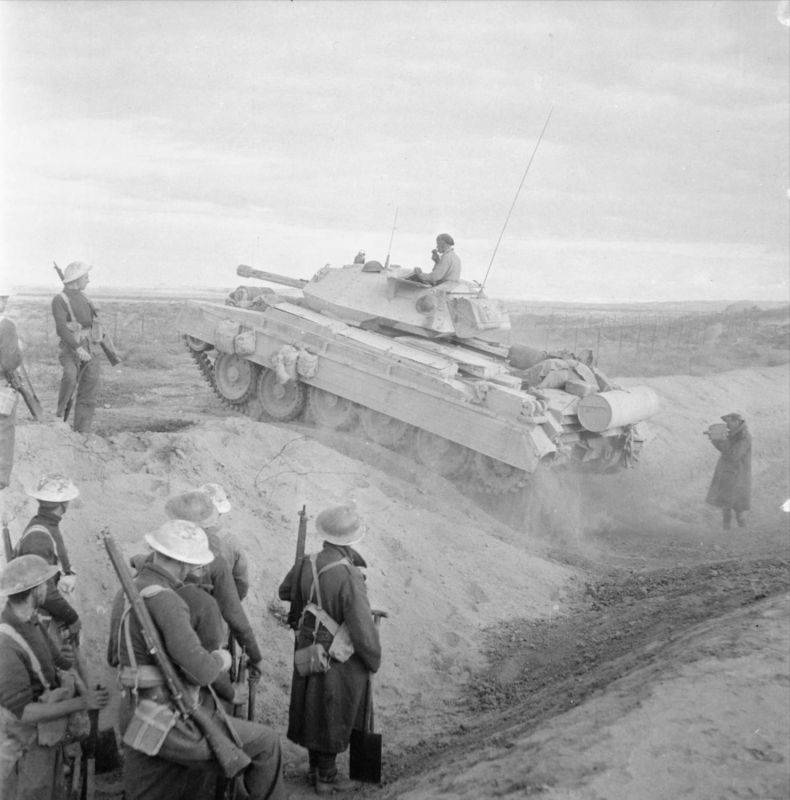
British tank Crusader Mk. III overcomes the ditch under Mersa Matruh. November 1942
General situation. Preparations for the British offensive
In late August - early September 1942, the Germans tried to resume the offensive in the Alam-Khalfa region (Defeat of Rommel's army at the Battle of Alam el-Khalfa). However, Rommel's last offensive failed due to the lack of fresh troops, supply problems and the presence of large enemy reserves. In turn, the British counterattack also failed, as Rommel managed to withdraw the troops to well-fortified positions.
The British had air supremacy, the Germans were not receiving reinforcements, and the supply situation was deteriorating. The British sank convoys bound for Africa. The British, having superior forces and good supplies, began to prepare an offensive. The 51st and 44th divisions, a large amount of artillery and equipment, including American Tanks Grant and Sherman. By the end of October 1942, the British 8th Army was enlarged to 10 divisions, including 3 armored and 7 independent tank brigades. The total number of the army reached 220 thousand people (150 thousand were at the forefront) with 1 tanks and 100 self-propelled guns, 100 aircraft (700 fighters and 500 bombers) and about 200 thousand field guns. Another 1 tanks were on the way.
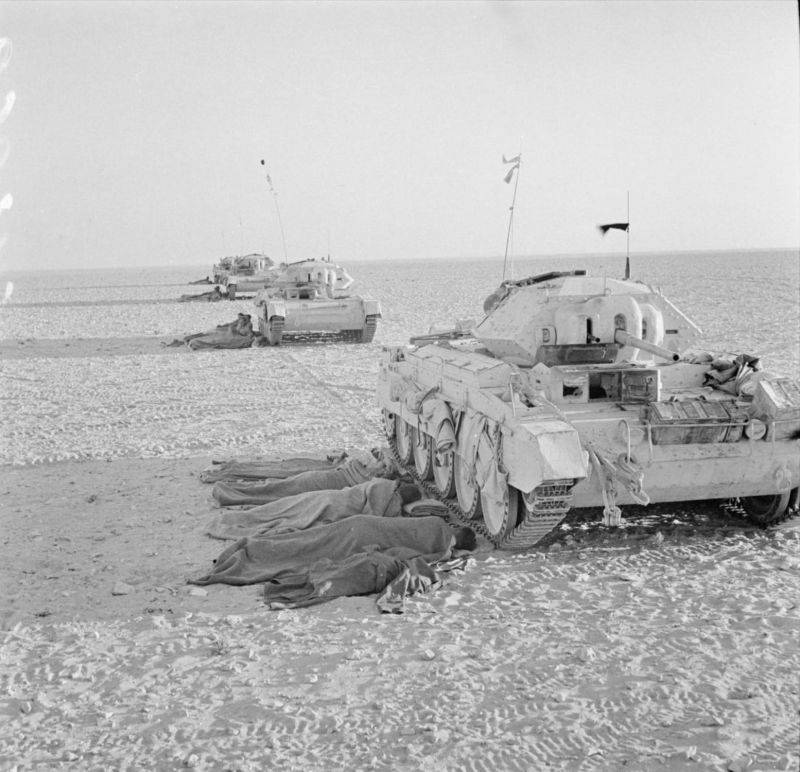
British tankers rest in the shade of Mk. VI Crusader in the Western Desert
The commander of the 8th Army, General Bernard Montgomery, was preparing a strike on the northern flank of the central sector of the front in order to break through the front and quickly reach the coast, surrounding the main enemy forces. The main blow was dealt by the 30th and 10th army corps. The 9th Australian, 51st, 2nd New Zealand and 1st South African Infantry Divisions broke into the enemy defenses, laid wide corridors in minefields. Then the 10th Corps, the 1st and 10th Panzer Divisions, entered the battle, which were supposed to destroy the main armored forces of the enemy. Pursuing the defeated enemy was the 2nd New Zealand Division, reinforced by the 9th Armored Brigade. At the same time, auxiliary operations, tying the enemy in battle, were carried out on the southern flank by the 4th Indian Infantry Division and the 13th Army Corps.
Commander-in-Chief of the British Forces in the Middle East, Harold Alexander, and Commander-in-Chief Montgomery did a great deal of preparatory work. Pipelines for water and gasoline were erected, all warehouses were brought as close as possible to the front line. Various numerous layouts were created so that the enemy got the impression that the British were going to attack in the south. On the northern flank, on the contrary, tanks were disguised as vehicles using plywood. This disorientated the German command, which distributed the forces of the tank army along the entire front line.
The start of the operation was scheduled for October 23, 1942, two weeks before the start of Operation Torch, the American landings in Morocco and Algeria. That is, Rommel, even if he had held out for two weeks, then when the enemy landed in French North Africa, he would have to withdraw troops to Libya.
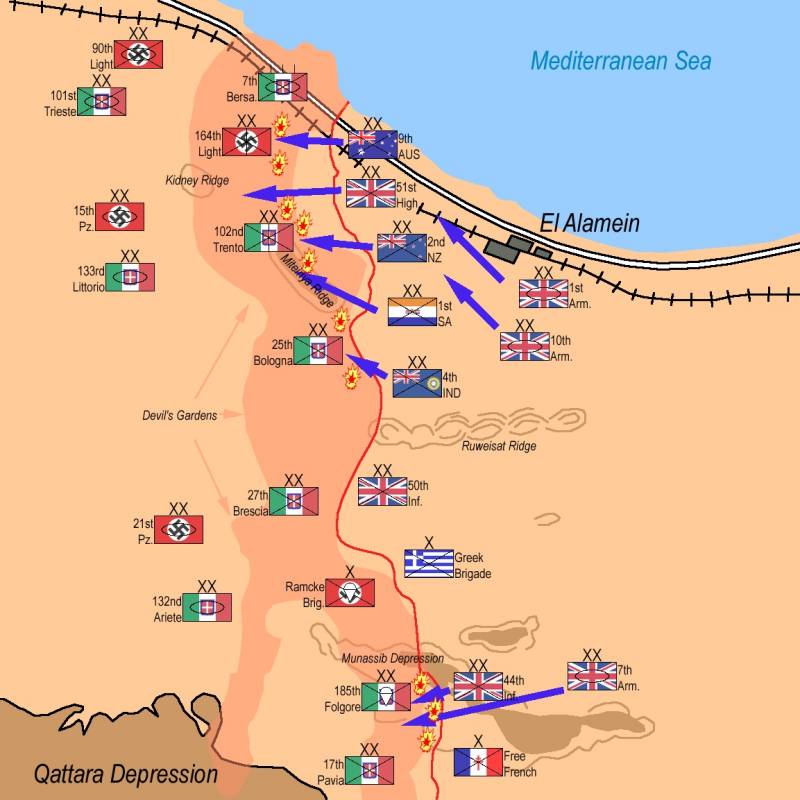
The disposition of the forces of the parties in the Second Battle of El Alamein
German-Italian forces
The Germans and Italians had 12 divisions (4 German and 8 Italian) numbering 115 thousand people with about 550 tanks. At the same time, the German tank army "Africa" was not fully staffed: it had 29 thousand people instead of 46 thousand. At the same time, there were many people in hospitals - up to 10 thousand. More than 1 thousand soldiers were sick in the parachute brigade. The German divisions fully existed only on paper: about 15 people remained in the 3th Panzer Division with a staffing strength of over 900 thousand people, in the 9,1st Panzer Division - 21 people, in the 3th and 900th light divisions - 90 and 164 thousand people.
The Germans were able to organize a fairly dense and strong defense. They set up a dense network of minefields. Over 164 anti-tank and 10 anti-personnel mines were delivered in the sector of the 11,4th division alone. Three lines of fortifications and minefields were placed along the northern flank, which made it possible to divide the attacking enemy formations and destroy them with artillery fire. But due to lack of personnel and weapons the depth of defense was only 8 km.
Due to lack of fuel and in view of the enemy's dominance in the air, Rommel abandoned his usual concentration of mobile forces, he divided them into two groups, trying to cover the entire line of defense. The northern group included the 15th Panzer Division and the Italian Panzer Division "Littorio", the southern group - the 21st Panzer and the Italian Panzer Division "Ariete". The coastline in the rear from al-Rahman to al-Ghazala was defended by the 90th division. Motorized division "Trieste" was located near el-Bad. Part of the Pistol division stood at Mersa Matruh, the rest of the units were on the defensive. Italian troops, reinforced by the Germans, kept the defense in the first line.
On the northern flank from the sea and beyond, the defense was held by the Italian 21st Corps - the 12th Bersaglieri Regiment (selected Italian infantry), the German 164th division and the Italian motorized division "Trento". Further north, the Italian infantry division "Bologna", reinforced by half of the German parachute brigade, defended. On the southern flank stood the Italian 10th Corps - the Pavia and Brescia infantry divisions, reinforced by the Falgore parachute division and part of the German parachute brigade.
The German commander Rommel, who was seriously ill, on September 23 went on vacation to Austria for treatment. The army was received by General of the Tank Forces Georg Stumme, recalled from the Eastern Front. On October 24, Stumme fell out of a car attacked by an English plane at full speed and died of a heart attack. The field marshal had to urgently return to North Africa without completing his treatment.
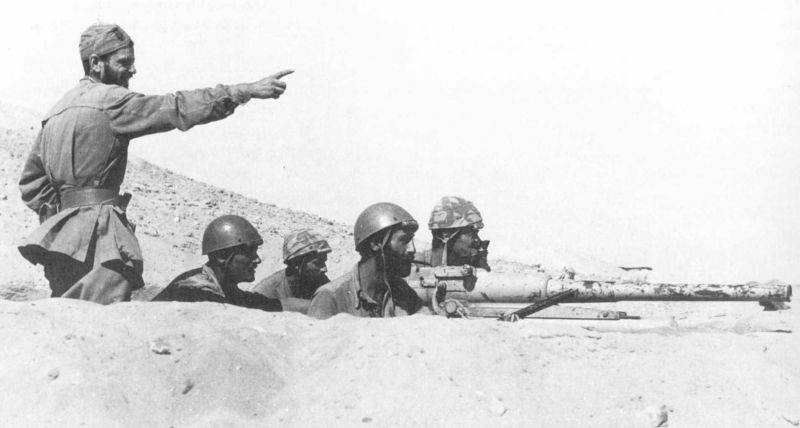
The anti-tank position of the paratroopers of the 185th Italian division "Folgore" near El Alamein at the 47-mm anti-tank gun Cannone da 47/32 M35
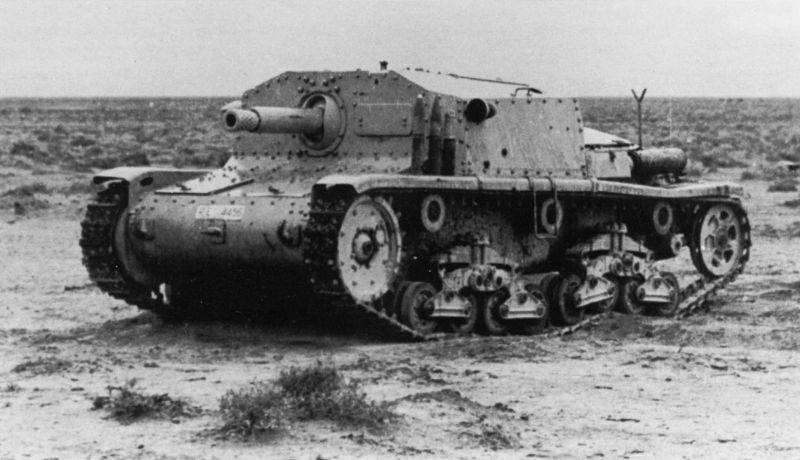
Italian self-propelled artillery Semovente M.40 da 75/18 based on the Fiat M13/40 tank near El Alamein. October 1942
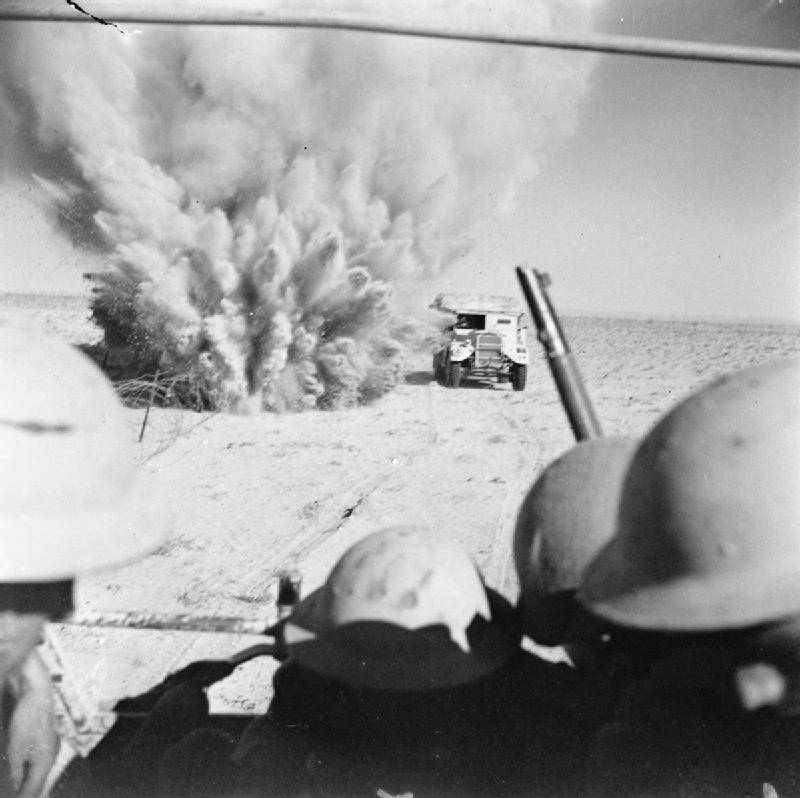
A British truck is blown up by a mine. October 1942
German-Italian troops beat off the first blow
On the night of October 22-23, 1942, British troops returned to their original positions. At 21:40 on October 23, 1 guns began artillery preparation. Then 200 thousand soldiers, supported by 70 tanks, went on the offensive.
But by the morning of the 24th, the offensive began to fade due to the strong resistance of the German 164th division and the Italian 102nd Trento division. The area was small, the tanks could not break into the operational space. Allied troops came under dagger fire from enemy artillery and suffered heavy losses.
Divisional operations by the 44th Infantry Division and the 7th Armored Division in the southern sector were also unsuccessful. The 13th Corps of General Horrocks ran into minefields, and the 2nd French Brigade was badly battered by enemy counterattacks.
During the day, Montgomery launched tanks into the attack. The 2nd armored brigade reached the edge of the minefield, but could not break through the entire defense. In the south, near the el-Miteiriya ridge, the attack bogged down. By evening, the enemy defenses had not been broken through. The German-Italian troops held out well. The German 15th Panzer Division counterattacked the British 22nd Armored Brigade. In the evening, the command of the British 8th Army decided to withdraw and regroup the tank divisions of the 10th Corps.
On October 25, the situation did not change. The 2nd New Zealand Division did not break through the enemy defenses. On the southern flank, the 13th Corps went on the defensive. On the 26th, New Zealand and South African infantry were able to capture several positions on the el Miteiriya Ridge. The rest of the areas were quiet. In four days of hard fighting, the British battalions thinned noticeably, 200 tanks were lost. Montgomery was stunned by the impending failure.

The deterioration of the position of the army "Africa"
The commander of the 8th Army did not abandon the offensive. On the evening of October 26, Montgomery decided to move the center of gravity of the operation closer to the coast. The New Zealand Division was ordered to move back to regroup. Meanwhile, on the 27th, the Germans transferred the southern mobile group to the north. The 21st Panzer Division is trying to launch a counterattack. However, the German tanks ran into the fire of British heavy tanks and anti-tank artillery. On October 28, the Germans try to repeat the attack, but this time they were stopped by the Royal Air Force.
On October 29, British troops resumed their offensive. The 9th Australian division was able to push the German 164th division. But when intelligence reported that the Germans had the 90th division in the second echelon, Montgomery shifted the main attack south to the area of the 2nd New Zealand Division. On the night of October 30-31, the Australians continued to push the 164th enemy division to the sea. However, the Allies were pushed back by a counterattack by units of the 90th Light and 21st Panzer Divisions. The Germans took 200 prisoners and knocked out 20 enemy tanks.
However, the German army suffered heavy losses. In the 21st Panzer Division, out of more than 140 tanks, about half remained, a similar situation was in the 15th Division. There was nothing to replenish these losses. Fuel was running low. On October 27 and 29, the British destroyed transports with ammunition and fuel on their way to Libya. Rommel decides to retreat to the Fuka line, which was about 100 km to the west.
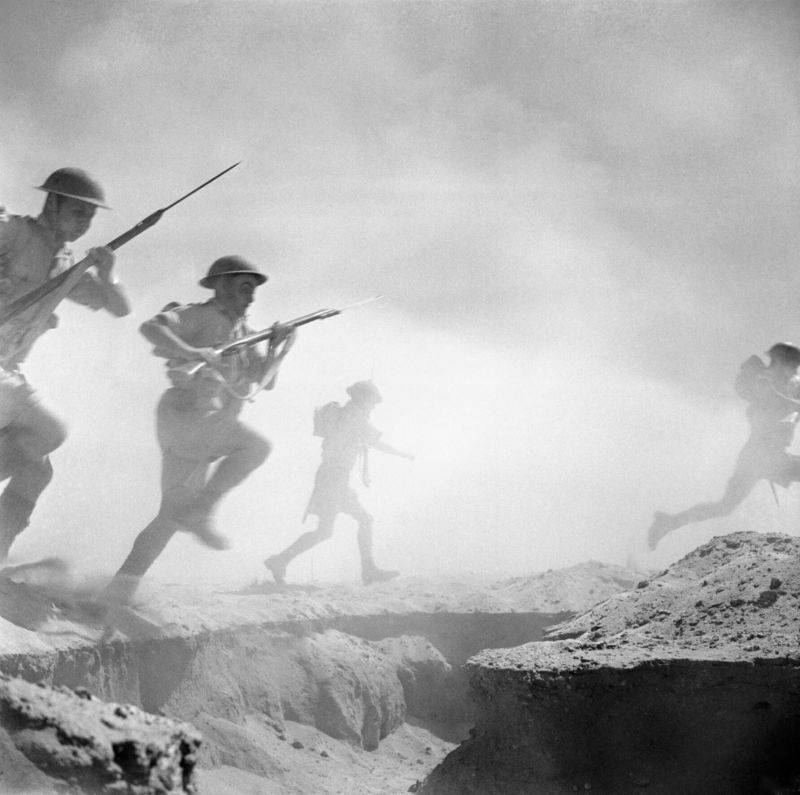
Australian soldiers during the attack near El Alamein. October 24, 1942
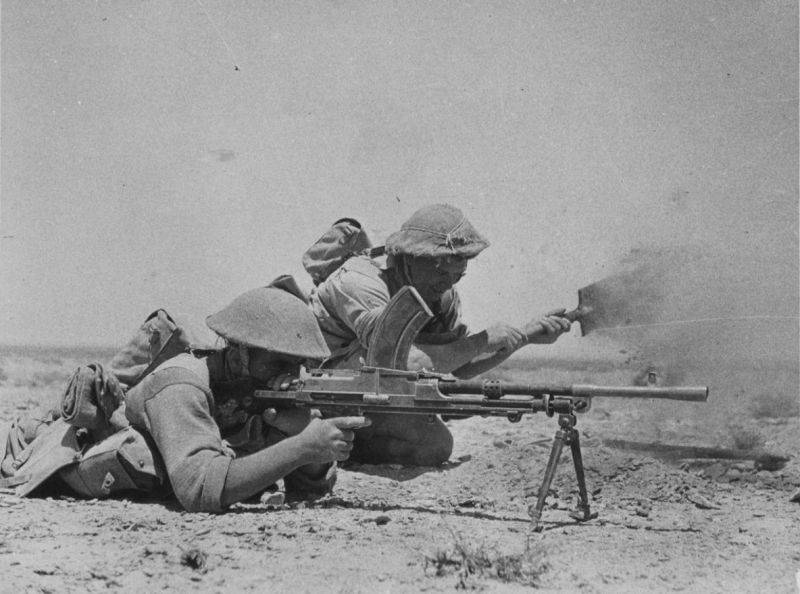
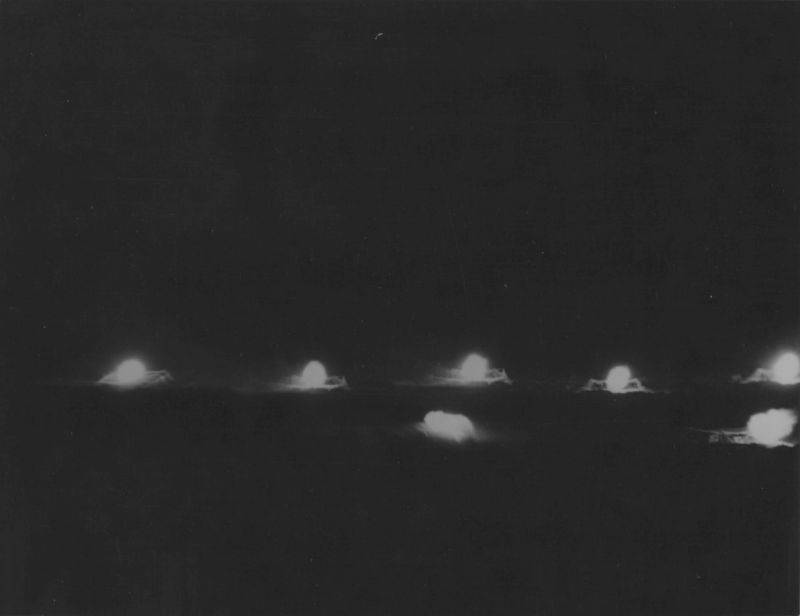
British artillery shelling German positions near El Alamein at night
To be continued ...
Information